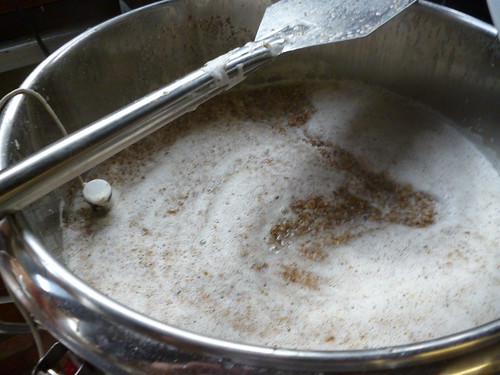For me, the most annoying part about the all grain brewing process is doughing-in. I would add the required amount of strike water to the mash tun and then get SWMBO to pour grain while I stirred. It took ages, having to add things slowly enough to not get dough balls and it covered everything in clouds of dust from the flour'y part of the milled grain. That is without mentioning how annoying it was to do alone!
I didn't hear this coming up as a common annoyance for most people so I figured there must be something I was missing, I started to google and found 'underletting' as a concept. I don't know if this is just the way that everyone does it and I have somehow missed it but it is so much easier.
For the uninitiated, you add grain to a dry mash tun and then add the strike water using the valve at the bottom you would usually drain wort from. You wait until all of the strike water has been added before giving it a quick stir and you're done.
I did this yesterday for the first time, using the same strike water temperature as usual I overshot my initial mash temperature by 4 degrees, which should give an idea of how fast it is compared to my normal method. Also has the advantage that I can weigh out grain and pour everything in outside, avoiding the flour clouds, whereas doughing-in outside and carrying a tun filled with grain and water would have been problematic. No doughballs either, can't believe I am only just trying this for the first time.
As I say, this may be just how most people do it, but I just wanted to share in case it helps anyone else.
I didn't hear this coming up as a common annoyance for most people so I figured there must be something I was missing, I started to google and found 'underletting' as a concept. I don't know if this is just the way that everyone does it and I have somehow missed it but it is so much easier.
For the uninitiated, you add grain to a dry mash tun and then add the strike water using the valve at the bottom you would usually drain wort from. You wait until all of the strike water has been added before giving it a quick stir and you're done.
I did this yesterday for the first time, using the same strike water temperature as usual I overshot my initial mash temperature by 4 degrees, which should give an idea of how fast it is compared to my normal method. Also has the advantage that I can weigh out grain and pour everything in outside, avoiding the flour clouds, whereas doughing-in outside and carrying a tun filled with grain and water would have been problematic. No doughballs either, can't believe I am only just trying this for the first time.
As I say, this may be just how most people do it, but I just wanted to share in case it helps anyone else.





















![BREWING THERMOMETER STICKERS ACCURATELY MONITOR FERMENTING BEER & WINE LIQUID TEMPERATURES 5PCS HOME BREW SPIRITS WINE LCD ADHESIVE [US]](https://m.media-amazon.com/images/I/311DDjo2X3L._SL500_.jpg)





















